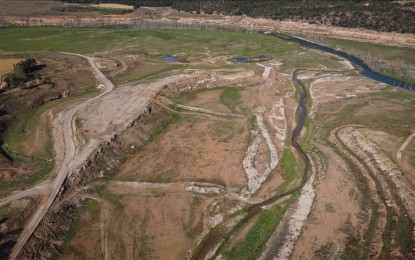
An aerial view of the Rialb reservoir in Lleida, one of the largest in Catalonia, Spain on May 30, 2023 (Photo from Anadolu)
OVIEDO, Spain – For the first time, the government of Catalonia declared a drought emergency, announcing on Thursday new restrictions that will affect around 5.9 million people.
“It is the worst drought on record,” Catalan President Pere Aragones told a press conference. “Climate change is testing us like the pandemic.”
The reservoirs that provide water to around 80 percent of the Catalan population are just 15.8 percent full, after a prolonged drought and a recent abnormal dry spell.
The Catalan authorities said they may need to bring in drinking water by boat before the summer, something also seen in 2008.
The city and province of Barcelona, the city of Girona, and most of the surrounding area, as well as much of the Costa Brava, are entering an emergency phase and will have to cope with new restrictions from Friday.
“I am absolutely convinced that with collaboration, anticipation, and a huge collective effort, we can overcome this drought,” said Aragones.
The emergency declaration aims to limit water consumption to 200 liters (52 gallons) of water per capita, a figure that includes economic and commercial activities.
Any municipality that exceeds the water consumption cap will have to reduce the water pressure or cut off water for certain hours each day. If not, they will face fines from the regional government.
Prohibitions on use
At the moment, the City of Barcelona consumes 173 liters of water per day, so it will avoid being forced to impose water cuts for now. But, as reservoirs dry up, new emergency phases will be enacted, lowering caps to 180 liters per day and then 160 liters per day.
Economic sectors will already be hit with water cuts regardless. Agricultural activities will have to reduce water use by 80 percent (50% for livestock) and industry will see water cuts of 25 percent.
Filling most swimming pools will also be forbidden unless the establishments use salt water and aren’t connected to the public system or if the pools are used for sports and can show responsible water use or have recirculation systems in place.
Ornamental lakes, fountains, or other “aesthetic uses” of water will also be illegal unless they are used to protect specific species of animals.
Watering gardens with drinking water has already been banned for months, as the areas already had “pre-emergency” restrictions in place.
One exception has been the watering of trees or historic gardens to ensure they stay alive. However, if the emergency reaches phase three, only special trees will be deemed worthy of the scarce water.
New projects that will require intensive water usage such as new farms, urban plans, or tourism projects will also be banned as well.
Besides the lack of rain, last year was the hottest year on record for Catalonia, further pulling moisture from the land.
In Barcelona, this past January was also 2.2°C (4°F) warmer than the average month, smashing all records since record-keeping began in 1914, according to the Fabra Observatory. The hottest day reached 21.2°C (70.16°F).
Looking ahead to next week’s forecast, not a drop of rain is expected for Barcelona either, according to the Spanish meteorological agency Aemet. (Anadolu)
